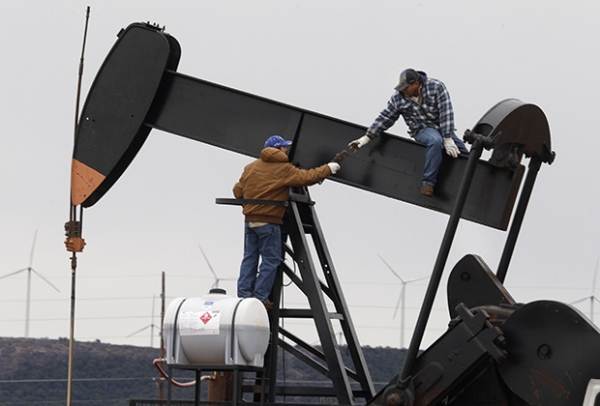
Oil producers worldwide are in trouble because of the collapse of prices. In the latter it is customary to blame the American shale oil industry, which in few years has provided a glut in the market. Though kancevica survive the era of cheap oil is especially hard. But still hanging on in spite of everything, although a wave of bankruptcies of oil companies in North America have already begun.
According to consulting firm Baker Hughes, the rig count in the US by mid-February dropped to 416, despite the fact that just a year and a half ago there were four times more — 1600. The situation indicates a severe crisis in the American oil industry, and especially in the production of hydrocarbons from oil shale (it accounts for more than 80 percent of wells).
However, other indicators of production rather say some stabilization, but not collapse. On 12 February, according to Energy Information Administration, the U.S. was extracted 9,135 million barrels of oil per day (about 9 per cent of global oil production). The record here was set in early June 2015, when production at U.S. oil fields has reached 9,61 million barrels a day. Thus, the total decline from the peak has amounted to about 5 per cent — significant, but not catastrophic.
Moreover, if you look at the statistics of recent months, you can come to the conclusion that oil production in the US has reached a kind of plateau. Record the last 14 months was placed at the beginning of October (9,096 million barrels); since then, production levels fluctuated around the mark from 9.1 to 9.2 million barrels. Reservoirs for the surplus of oil continues to fill up. Last week of industrial stocks has reached 504 million barrels, once again updating the record. Reserves are growing more slowly than expected by market analysts, but still growing, and this fact continues to exert strong pressure on the market. It’s no joke — the current U.S. reserves will last for a month, even in the complete cessation of production and imports.
Thus it can be stated that the shale industry in the US at the moment, successfully holding the strike, presumably, Saudi Arabia (the most common version, which explains the sharp drop in prices, the increased production Riyadh, had set the goal to stifle American oil production). After another year and a half ago, it was expected that the price of 60-70 dollars per barrel for producers of shale oil would be unaffordable. In principle, most analysts predicted that in 2015 the industry will survive, but so weak a reaction to difficulties came as a surprise. It is already clear what exactly caused the stability of the industry.

Photo: LM Otero / AP
First, active hedging of supplies. 2015 American suppliers prudently insured thus more than half of its production. This has enabled many of them quite safely sell oil if not at pre-crisis prices, then at least, quite reasonable, to discourage spending and investment and to repay the loans.
Secondly, the situation eased extremely low interest rates in the credit markets, allowing producers to borrow funds at favorable interest rates. In another situation, the debt burden would become unbearable, it’s one thing to repay loans taken under 4-5 percent (for large companies sometimes even less), and another thing — under 8-10 percent.
Much has been said about the progress in technology, but analysts and the oil companies themselves are often guilty of substitution of concepts. The main technological breakthrough associated with the introduction of horizontal drilling technology and hydraulic fracturing (which, in fact, allowed to extract hard-to-reach hydrocarbons) occurred in 2000-ies. After that there were possible minor technology improvements, but nothing radical has happened — at least that would reduce the cost by half.
However, the production cost reduced, and significantly. This increase in efficiency directly with the technology of production is not connected: the fact that five years ago at the major fields like the Bakken and Eagle Ford companies had to work essentially in an open field — there was nothing but towers. Since then, the field has acquired infrastructure — from pipelines, roads, Railways and housing for employees. After the construction of all necessary expenses of the companies declined to hire labor, provide for the transportation of products from point a to point B — that is, to U.S. refineries — has become much cheaper.
Played a role and a system of leasing, which with small oil producers often work service companies and corporations that produce the necessary equipment. The oil boom led to a boom in the production of this equipment, warehouses companies Starinnyj. Now they have no choice but to offer their products at a discount is not to lie with her dead weight in the warehouse.
Finally, and most important: despite the fact that the number of rigs decreased by four times, continuing the work of wells — the most effective and rich reserves. They used to give the lion’s share of the production. Many of these sites will actually make a profit and at 40 dollars per barrel, and some, perhaps, and at 30. Another question that now is cherry picking, and this will have an impact in the future.
But not only therefore the situation in the oil industry of North America (not only of shale — deposits of tar Sands, too) looks quite serene despite the demonstrated last year resistance. The real test for American companies begins now.

Photo: Spencer Platt / Getty Images
According to research group IHS, 150 North American oil companies could go bankrupt if the current oil price — about $ 30 per barrel — will be held throughout the year or more. Deloitte estimates the potential failures in a third of the entire global industry, but special emphasis is put on the USA. Such harsh predictions are based not only on current prices but also on financial performance of companies.
As already mentioned, most companies insure themselves against the risks of price fall in 2015 by way of hedging. But in 2016 the share of such contracts is only 15-20 percent, and in 2017 — tends to zero. Companies will have to sell oil at reasonable prices, and revenues can’t cover costs and investments and the debt burden will grow.
The moment of truth may come in March, when the firms operating in the sector of shale oil, have to repay the interest on loans and bonds — $ 1.2 billion. The end of the year the amount of payments on interest only, excluding the principal, will make the industry almost $ 10 billion. This figure will not decline until 2021, and cash flow companies continues to decline.
In early February of Chesapeake Energy — one of the pioneers of the shale gas industry — expressed the need to restructure more than 10 billion debt. This news immediately brought down its shares, so the company had to clarify that she is not going to go bankrupt — at least not yet. In smaller companies the problem. According to a study by Bloomberg, about half of all current debt by industry accounts for tax code with a “garbage” rating.
In fact, bankruptcy is already going. Since the beginning of 2015 broke 48 companies, their total debt amounted to $ 17 billion. This is a relatively small number of small and medium-sized firms that hold a maximum of two dozen drilling. The really serious companies that operate with large sections still to come. Players openly admit that now I think only about how to survive, and don’t think about investments in the future.
By the way, this is another reason why oil continues to flow from the fields almost to the same extent, and at the peak of 2015. Market participants seek to extract as much as possible and to sell goods at any price, to pay off loans. While this production does not require additional investments — it makes sense to work to the maximum.
Thus, the prediction that the effect of lower prices will be felt at the level of production around mid-2016, is close to realization. By that time, firstly, will dry up many wells, giving the lion’s share of the product in 2013-2015. Secondly, the big players will start to go out of business, and at current prices, the competitors won’t be rushing to pick up their fallen banners.
However, to expect that these events will raise oil prices around the world, it is too early. The international energy Agency (IEA) estimates a surplus of oil on the world market of 2.6 million barrels per day by the end of 2015. He forecast demand in 2016 will grow slowly — no more than 1.2 million barrels per day. Thus from the Americans required the output dropped by 1.4 million barrels, provided that the other producers will not increase production, which is doubtful.
At a recent meeting of oil Ministers of Russia, Saudi Arabia and other key countries, a decision was made to freeze production levels recorded in January. And these indicators are higher than the average for 2015, at least, against Russia and Iran. Last and not plans to increase production by 700 thousand barrels. This means that oil in the coming months, likely to remain cheap, making matters worse for the manufacturers around the globe, but especially in North America.







